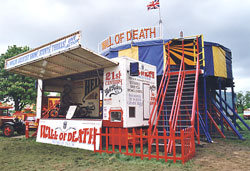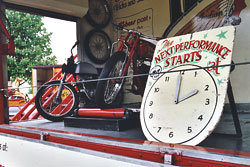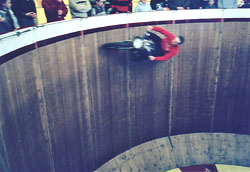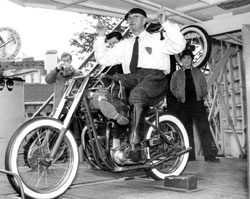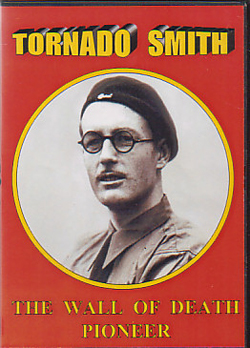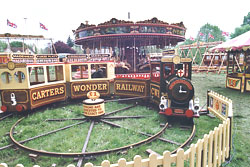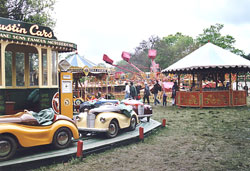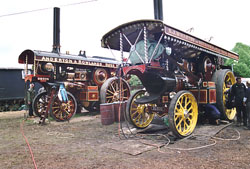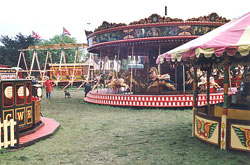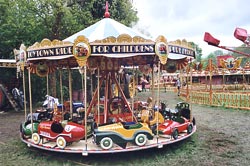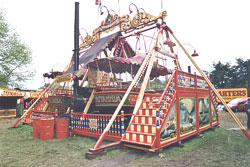|
|
|||||||
| HOME ARTICLES GALLERIES ABOUT US FORUM LINKS CONTACT JOYLAND BOOKS | |||||||
|
HORIZONTAL HEAVEN! KEN FOX, WITH CARTER'S ROYAL BERKSHIRE STEAM FAIR, AT PINKNEYS GREEN by Dave Page Article: From thegalloper.com, June 2004 |
|||||||
|
In newspapers, magazines and travel brochures these days it has
become trendy to talk about "things to do before your die" like
swimming with dolphins, skydiving, walking the Inca trail,
climbing Everest, or walking on the moon. DAVE PAGE went in
search of an elusive showland adrenalin rush at Pinkneys Green.
|
|||||||
|
Rides
on the fairground are all very well (and you could
never accuse Carters of putting on anything less
than a superb show week in week out through the
summer months) but what of showmanship these days?
Um... Well, is there any? This is a point that could
be debated for hours, but it is probably fair to
suggest that there is, perhaps, not as much as there
might be.
But all is not lost, for there may be a little something to do before you die turning up at a fairground near you this summer in the shape of the Ken Fox Wall of Death show - true horizontal entertainment that can be enjoyed with your clothes on! Ken's show is the only one travelling in England these days, or so it seems, and we caught up with him last month while he was appearing with Carters Royal Berkshire Steam Fair at Pinkneys Green, near Maidenhead. Ken Fox has showmanship coming out of his ears and his brand of adrenalin-soaked spectacle (not to mention the noise) sure beats the thrill of travelling around in circles on the back of a fibreglass horse! The Ken Fox Troupe provide a show of daring as good as any you'll see in a circus, with Ken leading the way with his superb display of solo trick riding on his 1926 Indian motorcycle. You would imagine that sitting backwards on a bike, or standing on one, or riding one while sat on the handlebars is hard enough under normal circumstances - but when the bike is horizontal and at speed it's a different story, although the whole show is so well oiled it all looks so effortless! Even for those of us who have seen the Wall of Death many times it never fails to impress. The speed, the noise, the danger, the fact that you are ridiculously close to the action in the spectator gallery and the constant expectation of having a tyre print across your face at any time. If you've never been before here's the deal. You are walking around the fair without a care in the world when you are suddenly deafened by motorcycle engines and the sound of fairground's number one spieler, Neil Calladine, encouraging you to step inside and see the "world's greatest live action show". The riders appear on the showfront to get the crowd going and before you know it you are paying your two quid and walking up a very steep staircase, emerging into what looks like a circus tent. Alas, the similarity with circus ends there as you stand looking into the abyss in the form of a gigantic wooden tube turned on its side. And it is here, on the walls of the tube, that the motorcycles (and even a go-kart) do their magic. The question on everyone's lips, of course, is how the heck do they do that? Well, the physics are pretty simple but that's only half the story. What really makes the show work is the unique blend of bravery, skill and fine judgment. But what is most surprising about the show is how young most of the riders are. Do their mother's know they spend their weekends doing this? So, what is a Wall of Death? "Motordromes" started in America in the early 1900s and are the natural evolution of wooden board motorcycle racing (sometimes called boardwall track riding). And what was all that about? Well, imagine a Wall of Death "track" as we know it today and then imagine racing around one that is so big it fits around the edge of a football pitch. Predictably, this was dangerous stuff and it was from these tracks that the phrase "Wall of Death" originated, for the simple reason that deaths were common among riders and spectators alike. In the end it all got too much and the sport was stopped, but this didn't put off many of the riders. Shortly afterwards portable "walls" began appearing at American carnivals as those deprived of a living by the ban looked to put food on their tables. The Wall of Death was first appeared in Britain in 1929 when a show was put on at the Kursaal in Southend. It was advertised as "America's greatest thriller, coming directly from Coney Island, New York". Over the years the Kursaal was to become synonymous with the Wall of Death in general and with one man in particular - George "Tornado" Smith. He was a great showman and owned a penny-farthing bicycle that he often rode through Southend advertising the show. Tornado Smith would perform various tricks on his Indian motorcycle including standing in the saddle, riding backwards and doing handstands on the handlebars. By 1934 he had introduced into the act a lioness, Briton, which at first sat on the petrol tank of the bike and sometimes on the crossbar. As the lioness grew larger, Smith made a sidecar for the animal! Today there are few remaining Wall of Death shows in the world and predictably most of them are in America. Ken Fox is the only show travelling in England now, so forget base-jumping off the Empire State Building because if there is one thing you REALLY need to do before you die it's going to see the Ken Fox show! Carter's Royal Berkshire Steam Fair - at Pinkneys Green Although Ken Fox steals the limelight on the site this month it is Carter's Royal Berkshire Steam Fair who are the stars of the annual extravaganza that is Pinkneys Green. What makes this event so special of course is the inclusion of steam engines, not that they seemed to be attracting much interest this year among those visitors who were not obvious camera-wielding fairground fans. Sad really because the ground was heaving on the Sunday. And speaking of ground it's surprising that the event happened at all given the conditions underfoot - and how Carters managed the build up, not to mention position the engines in the mire, is anyone's guess. So, what turned up this year? Here goes: Fowler B6 Showman's Scenic no. 20223 Supreme, which appeared to be working the slots arcade. Delivered in 1934 to Mrs Alf Deakin, Supreme was the fourth and final of the B6 Super Lions built by John Fowler & Co in Leeds. The B6s were the last batch of steam Showman's Road Locomotives built by Fowler. In 1942 Supreme was sold to Road Engines and Kerr of Glasgow and although busy during the war she was retired from service after a working life that spanned barely a decade. Regulars to this site will remember Supreme being an exhibit at Dingles Steam Village until recently, but she's now back with the Wharton family. Fowler 10 nhp Showman's Scenic no 19782, The Lion, which was on duty for juvenile work. Built in 1932 for Showmen Anderton & Rowland (Bristol), Lion was the first of the four Super Lion Showman's Class Road Locomotives and the first Fowler built with left-hand steerage. From new it also carried full Scenic crank fittings. Burrell Locomotive No. 3836 Starlight 6nhp, which was wired up to the Dive Bomber. Built 1920 as road locomotive but noted in later life with showmen R. Edwards & Son (Swindon). Burrell Locomotive No. 3949, Princess Mary 8 nhp took care of the Octopus. Built in 1923 and exhibited at the Smithfield Show Princess Mary ended up with showman William Nichols (Forrest Gate, London) and was noted with the Presland family, in 1943. Was this engine once called Pride of Dorset? Do let us know. editor@thegalloper.com Burrell Locomotive No. 3489, King George VI 6 nhp was working hard on the Chair-o-Plane. Built in 1913 as a standard road locomotive King George VI was noted with showman Swales Bolesworth (Leytonstone, London) and later spent time with showman E. Andrews (Kent). The King entered preservation in the 1940s and was the first ever engine to attend a Steam Engine Rally and seems to be quite a Pinkneys Green regular. Foster 7 n.h.p. Showman's Locomotive No. 14153 Admiral Beatty was manning the hooplas. Built in 1916, but not as a Showman, Admiral Beatty returned to Fosters in the 1920s for conversion for showman William Thurston (Northampton). And what of the fair itself? Well, as I sat down to write this I checked previous Pinkneys features just to make sure I didn't repeat myself, but what the heck. Nothing prepares you for how good Carter's Royal Berkshire Steam Fair is. Nothing you see on film, or in photographs, nothing you read in books or learn from listening to others is able to convey just what an eyeful it has become. Put simply, this is nostalgia in the raw. Genuine tackle, perfectly presented with an attention to detail that borders on the ridiculous. All the usual Carter big-hitters like the Gallopers, Dodgems, Chair-o-Planes, Yachts, Dive Bomber and Octopus were doing good business again this year, but it seems that the Jets are spending another summer back at the yard. But as ever it's not just the rides that make the perfect day out as it's the enclosed atmosphere created by the side stuff like the mirror show, nut sheet and shooters (not to mention the gorgeous looking juvenile section) that make this fair what it is. As ever, make sure you see it this year! |
|
The
most famous of all UK riders was perhaps Tornado
Smith, seen here at the Kursaal, Southend.
The cover of a new DVD on Wall of Death pioneer, Tornado Smith. he rode the Wall at Southend's Kursaal Amusement Park.
|
|||||
|
|||||||
|
|
|||||||
|
THEMAGICEYE | Terms and Conditions | Privacy Policy | Contact Us |
|||||||

